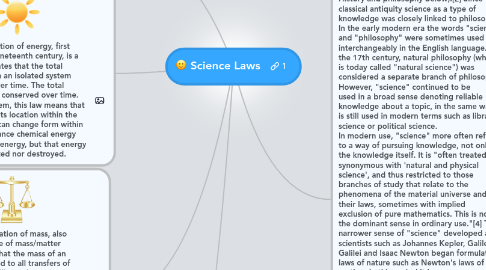Science Laws
by Joshua Hvidsten

1. In astronomy, Kepler's laws of planetary motion are three scientific laws describing orbital motion, each giving a description of the motion of planets around the Sun. Kepler's laws are: The orbit of every planet is an ellipse with the Sun at one of the two foci. A line joining a planet and the Sun sweeps out equal areas during equal intervals of time.[1] The square of the orbital period of a planet is directly proportional to the cube of the semi-major axis of its orbit.
2. The law of conservation of energy, first formulated in the nineteenth century, is a law of physics. It states that the total amount of energy in an isolated system remains constant over time. The total energy is said to be conserved over time. For an isolated system, this law means that energy can change its location within the system, and that it can change form within the system, for instance chemical energy can become kinetic energy, but that energy can be neither created nor destroyed.
3. The law of conservation of mass, also known as the principle of mass/matter conservation, states that the mass of an isolated system (closed to all transfers of matter and energy) will remain constant over time. This principle is equivalent to the conservation of energy: when energy or mass is enclosed in a system and none is allowed in or out, its quantity cannot otherwise change over time (hence, its quantity is "conserved" over time). The mass of an isolated system cannot be changed as a result of processes acting inside the system. The law implies that mass can neither be created nor destroyed, although it may be rearranged in space and changed into different types of particles; and that for any chemical process in an isolated system, the mass of the reactants must equal the mass of the products.
4. http://en.wikipedia.org/wiki/Atoms
4.1. CLICK HERE to see info. about atoms -->
5. Science (from Latin scientia, meaning "knowledge") is a systematic enterprise that builds and organizes knowledge in the form of testable explanations and predictions about the universe.[1] In an older and closely related meaning (found, for example, in Aristotle), "science" refers to the body of reliable knowledge itself, of the type that can be logically and rationally explained (see History and philosophy below).[2] Since classical antiquity science as a type of knowledge was closely linked to philosophy. In the early modern era the words "science" and "philosophy" were sometimes used interchangeably in the English language. By the 17th century, natural philosophy (which is today called "natural science") was considered a separate branch of philosophy.[3] However, "science" continued to be used in a broad sense denoting reliable knowledge about a topic, in the same way it is still used in modern terms such as library science or political science. In modern use, "science" more often refers to a way of pursuing knowledge, not only the knowledge itself. It is "often treated as synonymous with 'natural and physical science', and thus restricted to those branches of study that relate to the phenomena of the material universe and their laws, sometimes with implied exclusion of pure mathematics. This is now the dominant sense in ordinary use."[4] This narrower sense of "science" developed as scientists such as Johannes Kepler, Galileo Galilei and Isaac Newton began formulating laws of nature such as Newton's laws of motion. In this period it became more common to refer to natural philosophy as "natural science". Over the course of the 19th century, the word "science" became increasingly associated with scientific method, a disciplined way to study the natural world, including physics, chemistry, geology and biology. It is in the 19th century also that the term scientist was created by the naturalist-theologian William Whewell to distinguish those who sought knowledge on nature from those who sought knowledge on other disciplines. The Oxford English Dictionary dates the origin of the word "scientist" to 1834. This sometimes left the study of human thought and society in a linguistic limbo, which was resolved by classifying these areas of academic study as social science. Similarly, several other major areas of disciplined study and knowledge exist today under the general rubric of "science", such as formal science and applied science.
5.1. Newton's laws of motion are three physical laws that form the basis for classical mechanics. They describe the relationship between the forces acting on a body and its motion due to those forces. They have been expressed in several different ways over nearly three centuries,[1] and can be summarized as follows: First law: If an object experiences no net force, then its velocity is constant: the object is either at rest (if its velocity is zero), or it moves in a straight line with constant speed (if its velocity is nonzero).[2][3][4] Second law: The acceleration a of a body is parallel and directly proportional to the net force F acting on the body, is in the direction of the net force, and is inversely proportional to the mass m of the body, i.e., F = ma. Third law: When a first body exerts a force F1 on a second body, the second body simultaneously exerts a force F2 = −F1 on the first body. This means that F1 and F2 are equal in magnitude and opposite in direction. The three laws of motion were first compiled by Sir Isaac Newton in his work Philosophiæ Naturalis Principia Mathematica, first published in 1687.[5] Newton used them to explain and investigate the motion of many physical objects and systems.[6] For example, in the third volume of the text, Newton showed that these laws of motion, combined with his law of universal gravitation, explained Kepler's laws of planetary motion.


